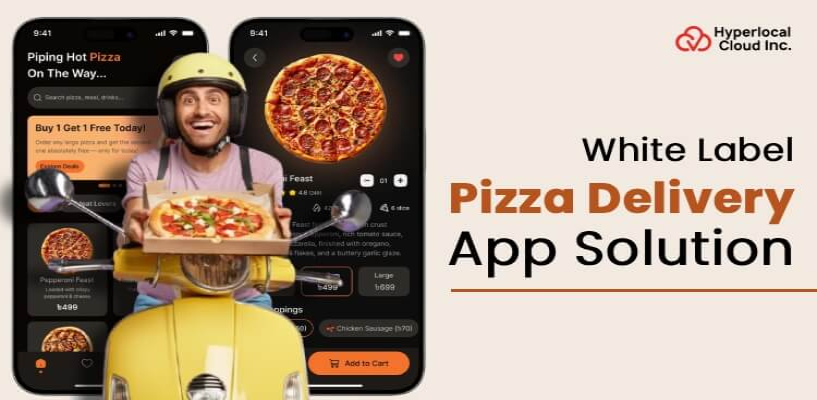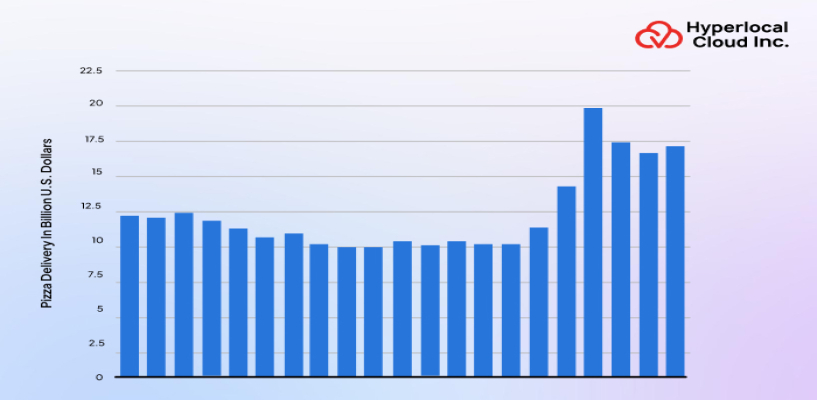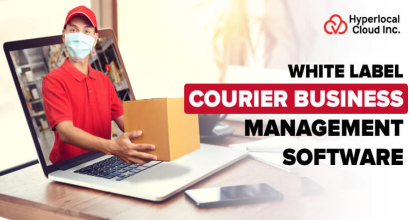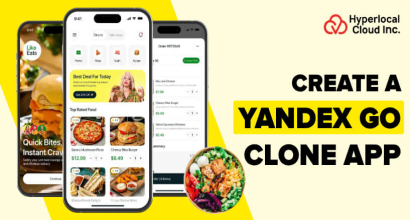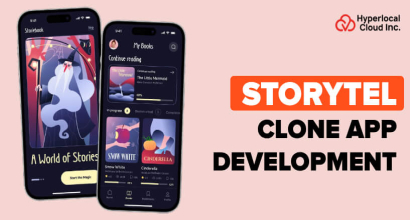s the pizza market size continues to grow, businesses are seizing the opportunity to build a pizza delivery platform, expanding their business operations. A white-label solution is a pre-built and customizable software solution that eliminates the need to create a platform from scratch, helping businesses to build their own brand identity.
In today's fast-paced world, pizza delivery apps have become the savers and have entirely changed the way we order food. UberEats, Pizza Hut, and Domino's have redefined convenience. If you are a pizza delivery business looking to invest in a pizza delivery app, you have landed on the right page! Businesses looking to invest in the pizza delivery app can easily provide their users with features like on-time pizza delivery with real-time tracking.
The pizza market around the world was estimated to be worth $272.40 billion in 2024. According to a report by Fortune Business Insights, the market is expected to grow to $409.50 billion by 2032 at a compound annual growth rate (CAGR) of 5.42% starting from $282.91 billion in 2025.
Source: Statista
What Is A Pizza Delivery App?
A pizza delivery application allows an individual to order a pizza online from different restaurants, customize their orders, and pay via numerous options that are accepted within the app.
Besides order placement, the app offers its users the opportunity to track their orders, special offers, and loyalty programs. Other popular pizza delivery apps are those of the major pizza chains, including Domino's and Pizza Hut. Implementing such a platform as Uber Eats, businesses can completely change the market of delivery.
Start Your Own Pizza Delivery Business Today!
How Does A Pizza Delivery Application Work?
It is a simple process that helps connect customers, restaurants, and delivery personnel. Through a pizza delivery app, customers can sign up to the app, view menus, customize their order, pay for their order, and view the delivery of their order in real-time.
1. User Registration & Browsing
The first step when a user enters the app is registration. Users must register an account on the application to proceed further and provide their basic contact information, which will allow them to access saved addresses and order history.
2. Order Placement
The app has an easy user registration. Once the user has registered on the app, they will be able to explore the online menu and see the pictures of the pizzas. Moreover, there exists the alternative that they get to customize their orders, which implies that they can select the size, type of crust, toppings, and sauces as they desire.
3. Checkout & Payment
Once the order has been customized on the app, users can proceed to place the order, and they can pay through a payment method that they have selected, such as a credit card/debit card, net banking, or mobile wallets.
4. Real-Time Tracking & Notifications
When a user places an order from the app, the notifications will be displayed to the user that "order confirmed", "order is being prepared", or "out for delivery." These different stages will help users track their orders in real time.
5. Feedback
Users will be able to rate their orders and forward their feedback (which will be valuable) to the delivery people or the restaurants when their orders are delivered.
Key Benefits of Investing in a White Label Pizza Delivery Platform Solution
Investing in a white label pizza delivery platform solution offers various benefits for businesses to boost their online presence, develop a vast user base, and generate revenue. Here are some of the benefits:
Lower costs: White label solutions are already developed solutions that offer some advantages, such as speed-to-market, cost, and risk reduction. These white label solutions still allow businesses to add their own logos, branding, and colors.
Faster marketing time: White label solutions are ready-made and do not require a long development process, which means that you can release a pizza delivery platform and services within a short time.
Increased brand control: A white label solution provider creates the product, and you will have full control over marketing, branding, and sales to customers.
Scalability: White label solutions allow a business to scale without requiring a massive overhaul of the system, and they provide a scalable solution.
Enhanced credibility & loyalty: Businesses are able to sell their products and services to their customers in the name of their brand. This assists business firms in brand building, credibility, and consumer loyalty.
Features of a Pizza Delivery App
The pizza delivery app comes with various features that facilitate different panels, such as for customers, for businesses, and for drivers. Let's have a look at the detailed information:
For Customers
User Profile & Order History: To use the pizza delivery app, users must first complete the registration process. During this registration process, users are required to enter their name, phone number, email address, and delivery address. Users can also add multiple delivery addresses and save them. The app will keep the order history of the users so they can view the past orders and quickly reorder.
Interactive Menu & Customization: By using this feature, users will access the menus with photos, and using customization options, they can customize their orders by adding their favorite pizza toppings or their favorite sauces.
Real-Time Order Tracking: The GPS integration will enable users to monitor their orders in real time, from the moment it is ready to be delivered to the estimated time of delivery.
Multiple Payment Options: The users can use several payment plans to make their orders based on the pizza delivery application, like credit/debit cards, online banking, mobile wallets like Google Pay, Apple Pay, UPI, and cash on delivery.
Push Notifications & Alerts: A detailed system of push notifications and alerts will make sure that every user is involved. These notifications/alerts would include, but are not limited to, the status of your order, delivery of the order, and promotions.
Loyalty & Promotions: The feature involves the use of coupon codes, loyalty points, and referral programs that reward loyal customers and bring in new customers.
Scheduling & Group Orders: Scheduling orders provides users with an opportunity to schedule orders to any date or time in the future. And the group feature enables users to take group orders.
Ratings & Reviews: In this feature, customers will have the option of rating and reviewing their orders and restaurants, which can be very helpful to them.
In-App Chat: It allows direct messaging between businesses, customers, and delivery partners about any inquiries.
For Restaurants
Order Management: Restaurants have the ability to easily handle orders, generate new orders, and monitor the order status.
Integrated content management system: With this functionality, the restaurant is able to add its new menu, descriptions, and quality photographs.
Payments: This feature will help restaurants accept payments and track their earnings on the application.
Marketing Tool: The Marketing tool allows restaurants to launch promotions and offer promo codes to their customers.
Communication Features: This allows restaurants to communicate easily with their customers and delivery personnel inside the application.
Estimated Delivery Time: It helps restaurants to calculate the estimated delivery time based on the load of the kitchen and the situation on the road.
Feedback Management: This feature helps restaurants receive valuable feedback related to their orders, and they can store these reviews and process them.
Reports and Analytics: Restaurants can easily see their statistics related to orders, basic information regarding couriers, and display the information on the dashboard. They can easily transform this information into internal CRM, accounting systems, and other relevant data management systems.
For Admin
Admin Dashboard: The admin dashboard will allow an admin to manage orders, inventory, and customer data through the analytics and tools of the app.
Inventory and Kitchen Management: This management system assists in the control of the stock levels and availability of products, which makes the operations run smoothly.
Multi-Outlet Support: This allows administrators to add multi-chain restaurants, custom menus by brand, and control locations.
Promotional Tools: These promotional tools enable admins to design and provide discounts, promotions, and loyalty programs to their clients.
Driver Management: This is used by the admin to add new drivers, monitor their performance, manage their information, and allocate deliveries to drivers.
Location Management: With this feature, the admin will be able to handle the concerned locations of the restaurants and their addresses.
Promotions Management: The promotion management option allows admins to generate and control discount codes, loyalty programs, and coupons, and attract and keep new customers.
Payment Management: This enables the admin to monitor all the payments made by the customers, like prepaid orders and cash-on-delivery orders.
Refund/Cancellation Management: Admin can process and manage the orders cancelled by the customers and manage the refunds when necessary.
For Drivers
Driver Profile: Drivers are able to create a profile on the app with the necessary information. They are able to use the app to see the addresses of customers, handle their delivery and the status of their order.
Geolocation & Navigation: It is a real-time locational tracking system that assists in efficient route optimization and delivery of orders.
Communication Features: In-app call or chat, which enables drivers to interact with restaurants and customers.
Order Details: The driver will be able to see detailed information, such as addresses of delivery, names of customers, contact details, and restaurant locations.
Availability Toggle: Drivers receive an option to make themselves available online or offline. This will enable drivers to determine whether or not they would like to accept a new delivery request.
Multilingual Support: The feature will fill the language barrier gap, where linguists and people of different cultures and languages can communicate with their customers easily.
Order Status Updates: This assists in keeping the system updated with the status of the order, whether it has been picked, accepted or delivered by the driver.
Delivery Notifications: This is an instant notification that is used to notify the drivers of the new order requests, status updates, and customer messages.
Route Optimization: The drivers can use this feature when they are making multiple deliveries; it helps to locate the best and quickest routes to deliver their orders on time.
Advanced Features or AI-driven Features of Pizza Delivery App
An on-demand app like pizza delivery offers numerous AI-driven features. By facilitating these features, your business can attract a large number of users. Read below about the advanced features that businesses or startups can integrate into their application:
AI-Powered Order Recommendation Engine
Machine-learning algorithms process customer purchase preferences and history to produce individual menu recommendations that raise the mean order value. The system continues to enhance its seasonal, time of the day, and trendy customer reviews-based recommendations to maximize conversion and customer satisfaction.
Smart Demand Prediction & Inventory Suggestions (for Restaurants)
Predictive analytics models are demand-based on past sales data, weather forecasts, local events, and seasonal trends as a way of assisting restaurants in managing their inventory. The system automatically re-orders and sends low-stock alerts that minimize food waste and maintain inventory at the top of the menu in the busiest times possible.
AI-Based Delivery Route Optimization
The advanced routing algorithms will handle real-time traffic, locations of delivery, availability of drivers, and priority of orders to provide the most efficient delivery paths and the least time wastage on delivery. The route optimization strategy is dynamic and constantly readjusts the routes to optimize various goals, such as fuel use, customer satisfaction, and driver workload.
AI Chatbot for Customer Support & Ordering
NLP technology will also provide the ability to communicate with the customer automatically and help the customer place the order, track the status, and troubleshoot with the help of conversations. The smart chatbot will simplify customer service processes, pass more complicated ones to human operators, and use this data to improve the accuracy of responses and customer experience.
Predictive Analytics for Business Insights (Admin Panel)
The best analytic dashboards provide business intelligence through data visualizations of actionable data on key business indicators, including sales trends, customer trends, and operational efficiency indicators. Automated reporting is created to detect anomalies and deliver alerts to the system, allowing it to conduct data-driven decision-making and long-term strategic planning to optimize business growth.
Get Your Own Branded Pizza App Now!
Understanding the Development Process of a Pizza Delivery App
Developing a pizza delivery app requires following several key steps that play a vital role. The on-demand app development companies typically employ the following methods, which can help businesses understand how to start an online pizza delivery business to meet their clients' requirements. Let's have a look at the development process.
Planning & Research
This is the process whereby businesses develop a blueprint of their ideas and then engage in the development stage. One has to look into the market trends of the pizza delivery app and then pursue it. Also, competitor and target market analysis can be a solid base for your app development.
UI/UX Design
The second stage is the UI/UX design, which is the design that is easy to understand and that draws the attention of users and makes them interested. Select an experienced mobile application development firm that has a mobile-friendly and user-friendly interface with the right prototypes and wireframes.
Choosing the Tech Stack
| Component | Tech Stack |
| Frontend | React Native or Flutter |
| Backend | Node.js or Python |
| Database | MongoDB or PostgreSQL |
| Payment Gateway | Stripe, PayPal, Razorpay |
| Cloud Platforms | AWS or Google Cloud Platform |
| Push notifications | Firebase Cloud Messaging (FCM) |
| APIs | Google Maps API |
Development
Among the two different ways of development, businesses can choose the one that best suits their requirement for app development.
Custom app development: A process of designing, building, and deploying software applications that is customized to meet the unique business requirements.
White label solutions: These are pre-built or ready-made solutions that are built by one company and are rebranded by another as their own. These solutions save time, effort, and costs while helping businesses expand their service offerings.
Testing & Quality Assurance
After the development of the app, it goes for testing, where highly qualified testers test the app both manually and automatically. This process is followed to eliminate bugs, glitches, or fix the flaws in the pizza delivery app.
Launch & Maintenance
The launching procedure is done by using the two operating systems, i.e., iOS and Android. Both the Apple App Store and Google Play Store allow businesses to launch their pizza delivery apps. Companies can reach out to a variety of audiences by launching the application on these platforms.
Practical Implementations of a White Label Pizza Delivery App
The pizza delivery market size has grown since last year, and several businesses and startups are leaping to enhance their digital presence by offering their customers hot, piping pizzas at their doorsteps. There are several businesses that can benefit from developing a pizza delivery app. Some of them are described below:
Local pizzerias expanding digitally
The small or medium-sized local pizza shops whose budget is low can quickly launch their pizza delivery platform. It will help them compete with large chains by providing a tailored digital experience.
Restaurant chains standardizing delivery
Both regional and national pizza chains can deploy a similar app across multiple outlets, enhancing their brand's loyalty using exclusive deals and rewards.
Food delivery aggregators adding pizza specialty
The food delivery aggregators can add a pizza-focused vertical to their customized app solution, supporting multiple vendors by retaining pizza-centric features.
Ghost kitchens or cloud kitchens offering pizza
Virtual kitchens without a physical dine-in space can leverage this opportunity to reach out to their customers. These businesses can focus on providing quick delivery, streamlining orders, and integrating an efficient kitchen workflow.
Franchise owners customizing customer experience
The franchises can customize the look and feel of their app to align with the current marketing strategies, improving engagement at the franchise level.
Monetization Strategies for Revenue Generation From A Pizza Delivery App
Businesses can use a variety of monetization strategies to make money from the pizza delivery app; some of the most relevant ones are summarized below.
Commission Fees: Since the app connects the restaurants to the customers, the app will take a percentage of every single order the restaurant makes.
Delivery Fees: The delivery fee is charged depending on the distance of delivery and is charged to the customer during the delivery services.
Subscription Plans: They allow businesses to provide premium subscription users with exclusive discounts, free delivery, or cashback, which results in customer loyalty and allows the business to generate a steady income.
In-App Advertising: It involves the process of allowing other food companies to advertise through the app and receiving money on their behalf.
Restaurant-Specific Services: It involves offering restaurants high-end services, including listing their brand name at the top of the list when a user searches for restaurants, gaining access to customer analytics tools to learn more about the market, and positioning the dishes of restaurants at the beginning of the menu.
Partnerships: Businesses or startups may collaborate with other complementary platforms or services, which provide them with an opportunity to expand their reach and earn joint revenues.
Create Your Pizza Delivery Empire Now!
The Development Cost for a Pizza Delivery Platform Using White Label Solution
The cost to develop a pizza delivery app using a white label solution starts at $5,000. However, the final price varies based on several factors, including the type of module choose. A reputable software development company offers two different modules: a custom-based app development model and by offering a white label solution. It totally depends on the startups or businesses to decide which option suits them best.
Other factors that affect the development cost are the app complexity, timeline, team expertise, advanced UI/UX interface, third-party integration, and AI-driven technologies.
Why Choose Hyperlocal Cloud to Build A Pizza Delivery App Using White Label Solution?
With years of experience, Hyperlocal Cloud is a reputable on-demand app development company offering robust and advanced mobile app solutions to businesses, startups, and entrepreneurs at affordable pricing. Our highly skilled developer team builds a pizza delivery app using advanced functionalities and features, helping companies to enhance their brand's presence and generate higher revenues. We offer 24/7 support, enabling required improvements or maintenance to the application. Reach out to our experts today and get your pizza delivery app developed.
FAQs
How can the app be customized to fit my brand?
You can customize the app’s logo, colors, menu, pricing, delivery options, and other branding elements to perfectly match your pizzeria’s identity.
Is the app compatible with both iOS and Android devices?
Yes, the white label pizza delivery app is designed to work seamlessly on both iOS and Android platforms.
Can I manage orders and deliveries through the app?
Absolutely! The app includes an easy-to-use dashboard for managing orders, tracking deliveries, and handling customer communications in real-time.
Does the app support multiple payment methods?
Yes, the app supports various payment options, including credit/debit cards, digital wallets, and cash on delivery.
Will I receive customer data and analytics?
Yes, the app provides valuable customer insights, order history, and analytics to help you improve your business and marketing strategies.
Can I offer promotions, discounts, and loyalty programs through the app?
Yes, the app allows you to create and manage special deals, discounts, and loyalty rewards to attract and retain customers.
What kind of support do you provide after launching the app?
We offer ongoing technical support, maintenance, and updates to ensure your app runs smoothly and stays up-to-date with the latest features.
How long does it take to launch my branded pizza delivery app?
Typically, it takes between 2 to 4 weeks to customize, test, and launch your branded pizza delivery app.
Can the app integrate with my existing POS or website?
Yes, the app can be integrated with your existing POS systems and website to streamline operations and offer a seamless customer experience.
